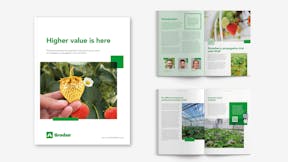In the world of horticulture, thinking innovative is key to meet industry demands such as high yields and products of high quality, while maintaining sustainable practices.
The idea to start the journey of transforming the strawberry cultivation and propagation industry came because growers of many crops worldwide are under pressure from several sides regarding food production systems and the same applies for strawberry growers since most of them grow outdoors demanding high amounts of water and land. Through cutting-edge techniques and our passion to high quality, we decided to redefine how growers can cultivate strawberries. Thomas, Business Development manager at Grodan project leader for strawberries was asked by Larry Aylward from Meister Media Worldwide to give an interview for the Canadian growers and talk about our vision. Before watching the interview we asked Thomas to explain us why is he so passionate about strawberries and he travels around the word to communicate with strawberry growers and generate new knowledge. While visiting a strawberry greenhouse with Thomas, we asked him to explain about the challenges faced by traditional growers, what are the differences between the traditional and the Grodan way of growing and the driving force behind Grodan's decision to focus on strawberries.

Higher value is here
A recent trial by Grodan has demonstrated that strawberries can be propagated and cultivated on a stone wool substrate while maintaining high quality and attractive fruit size. Additionally, the yields and Brix values were higher than with traditional methods. “Our trial has shown that we have enough knowledge to grow good strawberry plants on stone wool. Everything is ready for upscaling,” says Johanna Bac-Molenaar from WUR.






